It was a rainy, gray
morning when I arrived on Garfield Avenue (aka Main Street) at 9:45
am on July 8, 2006. I was there to watch the Greater Rolfe Days
parade and prepare to videotape the opening of two time capsules
from the Rolfe school property following the parade.
Because of the inclement weather, there was some doubt whether the
two parades—a kid's parade and the main parade—would be held.
However, after a short delay, both were carried off as though there
had been no problems, whatsoever. |
|
 |
| The main parade was a long, festive event with the
usual suspects, who seem to take pleasure in the parade, year after
year. My favorite part of the parade is the line up of Farmall and
John Deere tractors. I also love seeing horses in a parade, whether
ones with riders or the team of Percherons that pulled the wagon
that escorted parade marshal, Florence MacVey Faux MacVey (RHS
1943). It was also neat to see my father Deane Gunderson (RHS 1935)
riding on one of the two Lion's Club floats. Prior to leaving home
that morning, Deane pointed out that his gold trousers and red
sweater were the traditional Rolfe school colors and that his red
and white striped shirt was the Pocahontas colors.
What I like least in any parade—and the Rolfe parade was no
exception—is children who dash about, in what appears to be a greedy
manner, chasing after candy thrown into the street by the various
parade participants. A person would think that in this day and age
of programs such as Lighten Up Iowa, school districts that are
removing soft drinks from vending machines, public awareness of the
problems of too much sugar intake, and the near epidemic nature of
obesity—that there would be a moratorium on the airborne
distribution of candy at parades.
Perhaps some clever parade coordinator could think up an "I spy"
kind of game that would capture the attention of youth during a
parade. But then again, the attention of children could be on the
wonderful appearance of various floats, vehicles, and characters and
on the enthusiasm, playfulness, and community spirit exhibited by
the participants. Perhaps at the end of a parade, there could be
give-away booths where youth could get non-caloric, non-sugar items
such as a pencil, decal, balloon, or other treasures. But then
again, what do I know about modern day youth and the dynamics of
running a parade to suit a wide range of ages?
When I was on the committee to plan the 125th anniversary
celebration for Gilbert, there was a bit of discussion about the
problem of candy in parades. But the overwhelming sense of the
planners was that there was no way to control that kind of behavior.
It would be a real downer, I suppose, to have candy police at a
parade. However, in my humble opinion, some creative thought should
be given to the whole matter of children dashing after candy. Their
activity ruins the aesthetics of a parade, especially for a
photographer. It's also maddening to see children appear to be so
greedy. Besides, candy scraped up off a street, especially after the
horse have marched by, cannot be all that healthy. And the
consumption of all that cheap candy cannot be good for anyone. And
besides, there was plenty of other good food available on the
Greater Rolfe Days weekend.
In spite of the light rain showers during the parade, the weather
was generally good—neither too hot nor too cold—for the Saturday
events. |
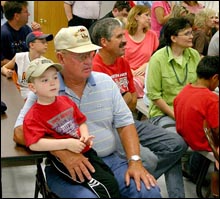 |
After the parade, people started milling into the
community center for the opening of the two time capsules that had
been retrieved from the Rolfe school property. At one point, there
were close to 100 visitors in attendance. There were many
generations of people, including several children, sitting at tables
with their bags of candy from the parade, sorting out or eating the
treasures that they had gotten. |
| Jeff Kerns (RHS 1978) was the emcee. Board members
John Behrendsen (RHS 1980), Dan Duitscher (RHS 1984), and Darwin
Eaton along with board president Ray Seeheusen and Superintendent
Joe Kramer also presided over the opening of the boxes. As Jeff said
when I talked to him in a phone call this week, "Rolfe was well
represented." |
|
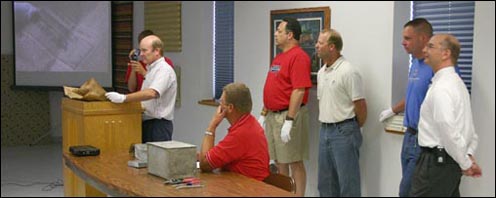 |
| The board had arranged for Peter
Seeheusen, a 2006 graduate of the PAC high school and son on the
board president, to videotape the materials on the lectern as Jeff
handled them and to project the images onto a large screen. As Jeff
said, "It helped a lot for people to be able to see the materials on
the screen—that way, they could see what I saw at the same time."
Ray Seeheusen was the recorder, writing down a
list of the items removed from each
box. |
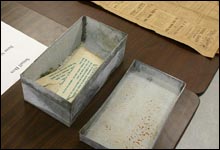 |
The first box to be opened was the smaller of the
two. It had been stashed in the cornerstone of the three-story Rolfe
school building when it was constructed in 1917. The lid of that box
was easily removed. Inside were some newspapers and a set of school
board minutes. |
| Jeff took a long time, turning the
pages of the newspapers and reading aloud some of the items in it.
An observer could say that he took too long and read too much
detail, and that doing so got the event off to a slow pace. However,
there seemed to be a lot of interest in those details. And the slow
pace may have calmed some of the people—perhaps even lowered their
blood pressure—who had a contrary attitude about how the school
district had handled the razing of the school or custody of the time
capsules. |
 |
The second box was one that had been buried by the
class of 1928 in the east pillar at the south entrance of the
school. It was a larger and much heavier box made of tin or zinc and
had been soldered closed. The board members had to use tin snips and
a screwdriver to open the box. Inside was a whole cache of items. |
Apparently, the class had opened, added
items, and resealed the box at its reunions in 1948, 1968, and 1978.
The class also asked the class of 1978 to contribute items to the
box.
Gradually, the pace of reviewing the items sped up. After each batch
was reviewed at the lectern by Jeff, projected on the screen, and
duly recorded, the materials were placed on long tables for public
viewing after the ceremony was concluded.
Asked about the event to open the capsules, Delores Hendrickson
Pederson (RHS 1952) said, "It was nostalgic and disheartening." She
thought there would be more in the box stashed away in 1917 than
just the Rolfe Arrow newspapers. However, she was particularly
impressed with the edition of the paper that included the floor
plans for the new school. Those drawings prompted her to try to
visualize what the Rolfe people went through to get the school
building ready for use. She was also impressed with how active the
community was in those early years, but reminisced that Rolfe had
continued to be an "active little town" even when she moved there in
1948.
In a related matter, Dee talked to school board member, Jeff
Kerns, after the opening of the boxes. She told him her concerns
about the victory bell that had been removed from the Rolfe school
property and placed on the grounds of the high school building in
Pocahontas. Dee said she and a number of other Rolfe people would
like to have the bell back in Rolfe and made part of a memorial to
the Rolfe schools. Apparently, Jeff told her that the bell had gone
along with the merger of schools and that Pocahontas had never had a
victory bell. Dee replied that Pocahontas could get its own bell.
Nancy Shelgren Martin (RHS 1951) said, "The program got really
long, but I enjoyed it." She took a bit of time after the ceremonies
to view the time capsule materials that the school board members had
been spread out on long tables. |
|
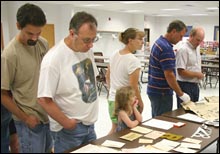 |
She said, "A person needed a lot of time just to
look at the papers—there was a lot of material there. I personally
knew several people from the class of 1928 and was particularly
interested in looking at the materials they had placed in their
box." |
| Nancy noted that the number of people
in the audience kept shrinking because there were so many other
Greater Rolfe Days activities that people wanted to attend. She left
the community room, and when she returned later in the afternoon,
all the materials had been put in boxes and taken to the library for
temporary safe-keeping. She talked to Superintendent Joe Kramer, who
assured her that the items would be scanned and the images made
available to the public. Phil Brinkman (RHS 1945) said, "The event
was real interesting, but it took so much time, that unless a person
was real involved with the history of the area, they could easily
have lost interest. It was hard for me to identify with the 1917
box, but when the 1928 box was opened, I started listening. I was
two years old then but have no memories of that year." Phil added,
"What I found very interesting—maybe because of my age—were things
like the newspaper ads and what things cost back then. It's
unbelievable how much things have changed. But then, of course, I am
an old dog."
Tammy Pederson Shimon (RHS 1983 and the daughter of Dee Pederson)
is the secretary for Rolfe Betterment, Inc. When asked about the
significance of the annual Greater Rolfe Days event, she said, "It
is a weekend of pulling together as a community, great camaraderie,
enjoying ourselves, and celebrating our home town."
When asked about the event to open the time capsules, Tammy's first
response was, "For me, it was an awful lot of newspapers." She
chuckled, then added, "You have a personal stake in it because of
growing up in the community and the fact that you went to the
school—and it's no longer up and running. The materials in the
capsules provide a legacy to our heritage and are a part of the
history of that school. It was important to be part of the event to
open those capsules and to see what people of another era felt was
important to preserve for the future. The box from the class of 1928
was supposed to be opened again in 2028, but we didn't have that
option." Later, Tammy said, "Even though there were a lot of
newspapers, knowing the history in them was important—especially the
plans for the school built in 1917—that was a real surprise. And it
was interesting to learn the original cost of the building." |
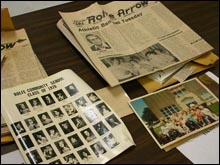 |
Tammy said that the materials that the class of
1978 deposited in the box established by the class of 1928 were of
special interest to her. She also said that the swing choir had been
very successful during that era and that both her husband Jim Shimon
(RHS 1979) and brother Troy Pederson (RHS 1980) had been part of the
choir. |
When asked about what she experienced
during the opening of the capsules, Tammy said that it was hard to
put her feelings into words. "It was very interesting, and you were
glad you were there to reflect on things and events."
Jeff Kerns had been part of that swing choir and said it was fun to
go through the copies of the Rolfe Arrow from 1978 that had been
placed in the box and see pictures such as the one of the swing
choir director, Paul Tapper, holding two large trophies. Jeff added
that the choir had gone to four different contests, including one in
Fremont, Nebraska, and won four, first-place trophies. According to
Jeff, "That had never been done before or since."Chris Simonson (RHS 1979) was also a member of that swing choir and
attended the opening of the time capsules. He chuckled and said, "It
was unusual in the 1928 time capsule to find contemporary
people—namely myself," referring to the photo and report in the
Arrow of the swing choir's success. Chris said, "I wasn't in sports
past my freshman year, and winning four out of four major contests
was like being in basketball and winning the state tournament. Paul
Tapper directed the choir and pushed personalities to the limit—in a
good way—and taught us a lot about the need to be focused and have
fun. He did not tolerate a lack of focus."
In describing the 1928 time capsule, Chris said, "It was not just a
snapshot of one year. It was both their high school and post high
school memories, and I am looking forward to seeing the scans and
being able to study the material more."
Donna Smith Behrendsen (RHS 1950 and mother of school board member,
John Behrendsen) said, "I was kind of disappointed in the event. I
thought there would have been more than just the Rolfe Arrows."
Unfortunately, she had to leave shortly after the second box was
opened so that her husband Virgil could get home and rake hay. Donna
admits, "I really don't know what I was expecting to be in the
boxes—perhaps I thought there would have been an item from the
school. The information from the early newspapers was interesting,
but I think we all knew a lot about the difference between prices
then and now. Of course, the younger kids wouldn't have realized
that a crate of peaches cost $1.59 then and costs $16 today." Donna
added, "I'm going back to the library to read the materials, and
maybe I will feel differently after reading them for myself."
Donna
commended Superintendent Kramer, saying, "I thought the event was a
very good gesture on his part and at this time. People felt better
about the boxes, knowing they were opened as part of the Greater Rolfe Days activities."
(It should be noted that the PAC school board has not made a
final decision about the fate of the time capsules and their
contents. Currently, the materials are housed at the Rolfe library,
but are not available for public viewing. They are fragile and need
to be handled with extreme care. Superintendent Kramer has asked me
to scan the items. I hope to spend time in Rolfe during July and
will scan the smaller items and, hopefully, transfer the audio tape
made by the class of 1928 to digital format as well. I am looking
forward to posting some of the material on this web site, and making
them available on CDs to the Pocahontas and Rolfe libraries as well
as the PAC school district. It may not be necessary to scan the
newspapers, considering that the Rolfe Arrow has already been put on
microfilm with copies available at the Pocahontas library and the
State Historical Society of Iowa in Des Moines.)
When asked what he expected would be in the time capsules, Virgil
Shelgren (RHS 1943) said, "I figured we would have a newspaper or
mementoes from graduation or baccalaureate. Of course, you think
that someone might have left a ring or string of beads." He knew
that at its various reunions, the class of 1928 had already opened
its box but said, "I didn't realize it was such a tight container to
keep out mildew and things such as that—everyone was thinking when
they planned that box." He added, "What intrigued me the most about
the event was the reading of items from the newspapers. Also, the
opening of the boxes was handled in a very nice way." When asked
what went through his mind during the ceremony, Virgil said, "I
thought about the school and how much it has done for the whole
community and for the kids who graduated from it. Rolfe had one of
the premier schools around here."
Jenealea (Cheryl) Hansen Hilton (RHS 1954) said, “The event was
wonderful, but it was a very sad day for our family.” When asked to
explain, she talked about how her family's heritage is interwoven
with the life of the Rolfe schools. Her great grandmother, Rebecca
MacVey, had taught at Old Rolfe, which was the original county seat
and site of the town. It was located about three miles northeast of
where Rolfe now stands, and there continues to be a cemetery and a
marker for the court house at the Old Rolfe location.
Genealea’s grandmother, Lottie Fisher, graduated from the Rolfe
schools in 1898 and was an elementary school teacher for the Rolfe
schools. Both of Genealea’s parents, Chet Hansen and Mildred MacVey
Hansen graduated from Rolfe, he in 1926 and she in 1928. Also, all
of Chet’s siblings graduated from Rolfe: Elwyn Hansen, Lolita Hansen
Leonard, and Velma Mason Hansen. Jenealea and all of her siblings
began school at Rolfe. Her brother, Jim, graduated from the Des
Moines Township school, but the rest all graduated from Rolfe:
Jenealea in 1954, Janice in 1960, and Julie Hansen Friedhof in 1967. |
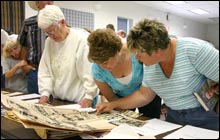 |
Genealea and her husband Denny had four
children—all graduates from Rolfe: Brent in 1972, Jim in 1975, Kevin
in 1980, and Sharri Hilton Mason in 1988. All but one of them was at
the event to open the time capsules. |
Jenealea and her family anticipated
that the opening of the boxes would be an important occasion. As
Jenealea said, “We knew that there would be all the stuff in the box
from the class of 1928—because my mom had talked about it. The class
had lots of big reunions and took lots of pictures, and I had been
there several times when the box was opened and resealed — I had
seen what my mom and some of her classmates had put in it.” Jenealea
did regret that some of the photographs had stuck together or
otherwise had deteriorated.
She continued, “We were very pleased with the way the superintendent
from Pocahontas organized the event and pleased to see three former
Rolfe students on the school board, even thought they don’t remember
the town the way we do.” Asked what she meant, Jenealea talked about
the days when the town was packed on Wednesday and Saturday nights.
“People parked up and down Main Street. Some even came early and
parked their cars so they could watch other people walking up and
down the street. There were lots of stores, a movie theater, and a
popcorn stand. There is little of that anymore.”
When asked what feelings she experienced during the opening of the
boxes, Genealea said, “It was sad. For some of us — it’s like the
ending of an era. The Rolfe school and education were always
important to my parents. People talk about the athletics at Rolfe,
but Rolfe also had some great music and speech programs.”
Genealea said that Mary McEwen Nelson and Ivadelle Cleal Porter are
the only living graduates of the class of 1928. Mary is in the care
center at Rolfe. Apparently, Ivadelle lives in Webster City.
Genealea said, “It is kind of sad that no one got in touch with
Ivadelle to tell her about the opening of the time capsule so that
she could have been here.”
Genealea concluded, “It was a great day, and I appreciate all of the
work and attention to detail that went into the event, but it
represented the end of the Rolfe school. When they opened those
boxes, it was a closure for me.”
Asked if he was nervous in anticipation of his role as emcee of the
opening of the time capsules, Jeff Kerns replied, "The only thing I
was nervous about is that we didn't know what was in the
boxes—whether there would be a lot of material or dust. Because of
that, there was no way to plan ahead." He added that it was
particularly exciting to open the box from 1917 because of the fear
that all of those materials could have deteriorated. It turned out
that the school board minutes from the meeting, when the new
building was approved, were included in the box. Those papers were
extremely fragile, and yet, Jeff was able to read that the amount of
the bond for the building was $65,000 at 4 1/2 percent interest.
Jeff says that following the event, Bill Winkleblack of the Rolfe
State Bank said that if the bond were issued today, the interest
rate would be the same.
Jeff noted that, when the ceremonies began, he could tell that some
of the people were particularly anxious to see the opening of the
box from 1928 because their parents had been in that class. Jeff
said, "The class of 1928 had been very close knit and invited their
children to their reunions, and it was easy to see that among the
people gathered for the opening." He said the crowd was also
interested in entries in the newspapers—such things as the corn and
bean prices and ads for a new plow or car.
In preparing for the event, Jeff had called Jayne Brinkman Hadley,
who had been the president of the class of 1978. He said, "I got a
heads up and wasn't surprised a lot." He reported that Jayne said
that the contents of the box had been prepared on short notice. The
class of 1928 had gathered for its reunion in 1978, and someone
found her uptown and asked if she could find items to contribute to
the box.
Jeff commented "What impressed me most was looking back and seeing
how much pride people took in the Rolfe school. In 1917, there was
community pride in the new building. In 1928, there was pride in the
school and the graduating class. It is good to get together to
reflect on the past—to see where we were and where we have come to.
As a board, we are looking at the possibility of a regional high
school due to declining enrollment in our district. As leaders of
the PAC District, we want to be on the front edge instead of being
reactionary. We like to study and research ahead of potential
problems so that we know where we are headed."
Regarding the fate of the victory bell that had been taken from
Rolfe and placed on the high school grounds, Jeff said, "Dan, John,
and I feel good about the bell being there. It is part of the
collective property of the school district. I like to see kids ring
the bell every time there is a victory. I don't view students as
being from Poky, Rolfe, Havelock, or Plover—all those communities
and their students are now joined in one school. Unfortunately, when
the Rolfe building came down, people seemed separated again. It
became Poky versus Rolfe. I hated to see that. There were kids from
other towns who attended school in Rolfe and had an attachment to
the Rolfe building. It is important not to view the current school
as the Pocahontas school but as the PAC District. Two of us on the
board wanted to repair the Rolfe building, but there were seven
members on the board, and it was a 5–2 decision to raze the
building. Now we are focused on how to move forward and give our
kids the best education possible and have them take pride in their
school. It is important to look at what's best for the kids. The
building is not there, but we need to move forward."
I, too, am extremely interested in the diagrams of the floor plan of
the school that was built in 1917. And I have heard that the
newspaper from 1914 includes an article about an architectural
consultant from Minnesota, who talked with a group—mainly of
women—from the Rolfe community about modern trends in the
construction of school facilities. It is impressive that the
three-story building contained both a gymnasium and auditorium in
addition to classrooms for 12 grades. |
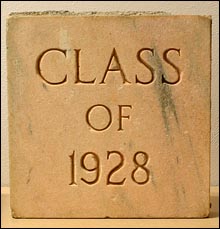 |
Newspaper headlines and articles tell only the
surface level of history. Because of that, I am also extremely
interested in materials left by the class of 1928—especially term
papers, round-robin letters, an audio tape made at its 40th
anniversary reunion, and envelopes containing written items. Perhaps
via those materials, those of us who are interested can learn more
about the heart and soul of the classmates of 1928. I knew many of
them quite well and was well aware of the cohesiveness of their
class.. |
| Mary McEwen Nelson is a resident of the
Rolfe Care Center. She and her husband LeRoy of the class of 1927 farmed southeast of
the cemetery and were members of the Presbyterian church that my
family attended. Mary seemed like the most gracious person I knew.
And she was beautiful, too. I believe that at one time, she was a
beauty queen for the Iowa State College yearbook, The Bomb. LeRoy was
one of my favorite people. He was gracious, too, but also had a
great sense of humor, and I fondly remember his chortle. He helped my father
find two horses for $50 apiece to give my siblings and me for
Christmas when I was nine in 1954. Arlo Ives was the father of my
classmate, Dallas Ives (RHS 1963), and farmed across the section
from our family. Lois Brinkman Hodaway also farmed across the
section and taught physical education in the Rolfe schools.
When we
were young, my siblings and I would sometimes stay with Jenealea
Hansen's mother, Mildred
Hansen, in town. She was a strict baby-sitter, but one I respected.
I recall the time that she would not let me go to the summer band
concert unless I put on a dress. I hated dresses, but I wanted to go
to the concert, especially so I could get popcorn at a stand on Main
Street owned by my great uncle Art Lighter, a single man and
linotype operator for the Rolfe Arrow. I thought I could get out of
wearing a dress simply because I had not brought one to town with me
for our overnight stay. But Mildred didn't buy into my rationale.
She found one of her daughter's dresses for me to wear, and I gave
in and wore a dress.
Jim Wilson was an insurance agent in Rolfe, and a dominating
business leader and Republican figure in the town. Russel Ives was a
genteel man, who retired in Rolfe after a job with the USDA in
Washington. I believe that Russel and Jim were part of the original
group that formed Rolfe Betterment, Inc.
It is too early to tell the full significance of the materials in
the time capsules. It was wonderful to have a public event, and it
was done well. Yes, the pacing could have been improved. But how
often does a school board or other group plan such an event? It is
an unpredictable kind of happening. For some people, the event may
have seemed long and like watching paint dry. But for those of us
with a long-time connection to Rolfe, who recognized many of the
names in the 1914 and 1917 newspapers and who knew many of the
people in the class of 1928, the event held our interest.
I also believe it was important for the Rolfe community to have a
ritual of coming together, reflecting on the life of its school,
reminiscing, laughing, and perhaps letting go—a form of grief work
regarding the loss of the school and all that it represented. That
kind of process can indeed be a step toward healing and moving
forward.
Holding a grudge or other bitterness over such things as school
mergers, the razing of a building, or the custody of time capsules
hurts the person who carries the grudge or bitterness more than it
hurts anyone else. And for that reason, forgiveness is also an
important element of healing and moving forward. That is not a
principle that is easy to practice, but it is sure worth trying,
even if we have valid reasons to think our own perspectives on an
issue are the right ones.
It is also wise to remember the opening lines of the "Serenity
Prayer" by theologian, Reinhold Niebuhr: "God grant me the serenity,
to accept the things I cannot change; courage to change the things I
can; and wisdom to know the difference." Or as the Zen
traditions emphasize, there is a time to detach and that too much
attachment cripples a person's health. Enough said. |
|
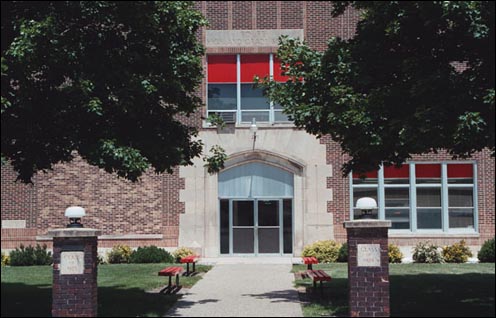 |
|










